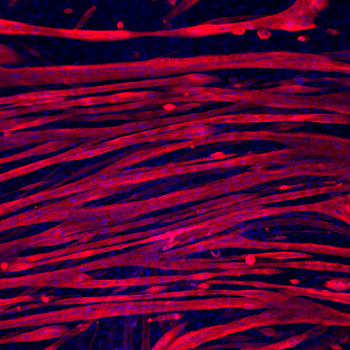Micromolded Gelatin Scaffolds for Extended In Vitro Culture of Muscle Tissue
By LabMedica International staff writers
Posted on 13 Jul 2016
A novel in vitro method for growing muscle tissue for an extended period of time depends on minute scaffolds constructed from gelatin.Posted on 13 Jul 2016
Gelatin is an irreversibly hydrolyzed form of collagen, wherein the hydrolysis results in the reduction of protein fibrils into smaller peptides, which have broad molecular weight ranges.

Image: Skeletal myotubes grown for three weeks on gelatin hydrogel (Photo courtesy of the McCain Laboratory, University of Southern California).
Culturing skeletal muscle in vitro has been problematic due to myotube delamination from synthetic culture substrates approximately one week after initiating differentiation from myoblasts. However, in the current study, investigators at the University of Southern California (Los Angeles) successfully maintained aligned skeletal myotubes differentiated from C2C12 mouse skeletal myoblasts for three weeks.
To accomplish this advance in culture technology, the investigators utilized micromolded gelatin hydrogels as culture substrates. The hydrogels were thoroughly characterized using atomic force microscopy (AFM).
The investigators reported in the June 28, 2016, online edition of the journal Scientific Reports that compared to polydimethylsiloxane (PDMS) microcontructs printed with fibronectin (FN), cell adhesion on gelatin hydrogel constructs was significantly higher one week and three weeks after initiating differentiation. Delamination from FN-microprinted PDMS prevented detection of myotubes.
Compared to a softer blend of PDMS microprinted with FN, myogenic index, myotube width, and myotube length on micromolded gelatin hydrogels was similar one week after initiating differentiation. However, three weeks after initiating differentiation, these parameters were significantly higher on micromolded gelatin hydrogels compared to FN-microprinted soft PDMS constructs.
"Disease and disorders involving skeletal muscle - ranging from severe muscular dystrophies to the gradual decrease in muscle mass with aging - dramatically reduce the quality of life for millions of people," said senior author Dr. Megan L. McCain, assistant professor of biomedical engineering at the University of Southern California. "By creating an inexpensive and accessible platform for studying skeletal muscle in the laboratory, we hope to enable research that will usher in new treatments for these patients."
Related Links:
University of Southern California













